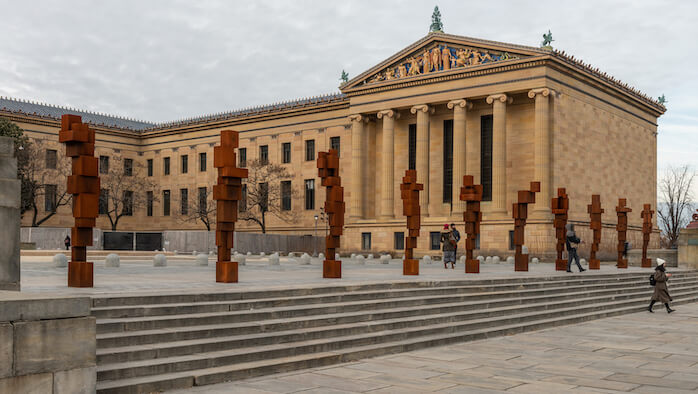Philadelphia is known for its public art installations, but the latest has been drawing some heated reactions. The Philadelphia Museum of Art has erected a row of 10 blocky iron statues along the top of its grand stairs, known to many as the Rocky steps – and some have already objected to the artwork’s placement at the city’s No. 1 destination for tourists and selfie-takers.
STAND is a new installation, erected Jan. 24 and up through Jun. 16, by U.K. sculptor Antony Gormley, a celebrated artist of international renown who has created installations in cities around the world. Many of his works are interpretations of the human body, often working and reworking forms based on metal casts of his own body. STAND is made up of 10 cast-iron sculptures from his series “BLOCKWORKS.”
The celebrated Brit’s work has gotten a Philly welcome.
“This is the dumbest thing I’ve ever seen,” tweeted Rocky imitator Mike Kunda. “It’s an ugly, rusted stain on the most beautiful set of steps in the world. …Shame. Philadelphia you are better than this.”
Critics even popped up in the Facebook comments on Art Museum posts about STAND: “Leave our Rocky steps alone. Its history, and many come to Philly just to run the steps,” one poster wrote.

Messing up the Rocky Steps?
But Gormley, 68, seems thrilled with the central location in Philadelphia.
“It’s quite important to me that this show is happening here, a foundational city in a way for American social values,” Gormley said during an Artist’s Voice talk on Jan. 24 at the Art Museum, “and the way that your museum, sitting on its hill, is in direct dialogue with City Hall, down this central mall … and the fact that the city contains many extraordinary works of public sculptures, whether its Washington on his horse or Joan of Arc nearly gilded and looking very bright on hers.”
As for the rusty patina? That’s a benefit from choosing an elemental material like iron, he said. “The red of its oxidization is in our blood,” he said. “The redness of our blood and the redness of the sun and the redness of rust are in a way calling to us to all recognize our relationship to planetary time and the elemental world.”

Antony Gormley with STAND. Courtesy of Philly Art Museum
Gormley’s urban installations have taken flack before. A life-size sculpture perched on the edge of the Empire State Building’s 24th-floor ledge in New York in 2010 led to daily 911 calls from passerbys terrified it was a real person about to jump. Then-Mayor Mike Bloomberg defended it as “great art.”
Gormley during his talk described his work as partly a critique of traditional public sculptures worshipping heroic figures. Stripped of individual, identifying traits, the figures he creates are intended to spark an internal reverberating dialogue in the viewer’s sense of self, space and time.
“I wanted this to be a haptic experience or revelation over your journey up the steps to this elevated cultural altitude,” Gormley said. “They’re very different when you finally out of breath get to the top of the steps and you feel them in relation to your body, and you feel the mass and heat. … Whether you like them or I like them doesn’t matter. Perhaps they’re being made for those that haven’t been born yet.”
You said it, pal.




























